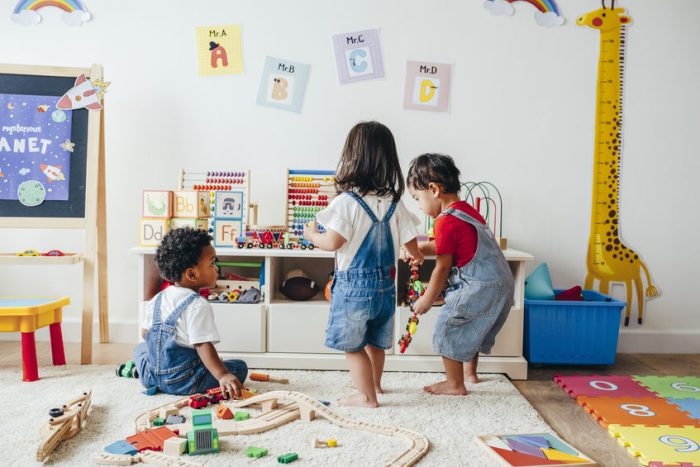
Maria Montessori discovered something special. The first female graduate of the University of Rome’s medical school, Montessori started her career in medicine by working with special needs children. This experience then inspired her to open schools for disadvantaged Italian youth, and that’s when she came up with an entirely new method for learning – child-centered education.
Montessori’s students didn’t sit down quietly and listen to her speak along with a rigid classroom schedule. Instead, she let the children discover and learn with their own senses. Over time, experts have realized that this is a vital step in the growth and development of tots, especially those aged 0 to 6. On top of that, these ages present the greatest capacity for learning in humans, and the exploratory Montessori technique takes advantage of that.
You can send your children to a Montessori school, of course, but you can — and should — incorporate the doctor’s methods into your home environment, too. Here’s why:
1. Kids Learn Must-Have Life Skills
Learning’s not just about textbooks and tests. Your children will also pick up life skills from an early age — a Montessori education helps them do so quickly. So, entrust your brood to become more independent and complete chores around the house as they get older. Even your two-year-old toddler can take part, so long as you choose age-appropriate to-dos for them and their older siblings.
Sometimes, this step will require a bit of demonstration and guidance from you. The first time your child tries a new task, you should first show them how it’s done. Then, supervise them as they try it out on their own. After that, you can trust them to wipe down the counters or take out the trash, for example. In starting early, you’re laying the groundwork for more help later — and, even more importantly, self-sufficient teens and adult children.
Read Next | 10 Tips for Creating a Great Homework Space for Your Child
2. Organization Will Improve
The Montessori classroom has a fine-tuned setup. You don’t have to follow all of Maria Montessori’s principles in making your home more aligned to her methodology. However, doing so can help you to make your housework better for you and your family. That’s because the Montessori method will implore you to give everything a designated place. Whether that means you’re organizing art supplies, toys or books, choosing a spot for everything will keep your place organized. Your kids will learn, too —if one thing goes in one spot, they can better help you organize, too.
To that end, a Montessori setup will better allow your kids to partake in such an organizational system. Indeed, Montessori herself wanted classrooms so that kids could access every inch. Low shelves, for example, allow little ones to reach and to put away their learning materials. You should have an equally low table and chairs, too. That way, kids can explore without needing to ask a grown-up for their reach — no interruptions means unadulterated learning.
Don’t stop with a learning-centered space, either. Place healthy snacks low in the fridge so that kids can reach them. Or, put their daily wardrobe into drawers they can reach. Even if their outfits down match, learning to dress oneself is an important, hands-on lesson for a little one to learn.
3. Children Can Hone Their Concentration
The Montessori method gives kids the chance to explore the things that interest them. Although it may seem that little ones don’t have much of an attention span, they do for the things they like. So, once you recognize their interests, provide them with all of the supplies they need to explore them. A workspace might be necessary, too, depending on how your child works best. Observing to figure this out is one of the most important steps in creating an at-home Montessori environment, of course.
Don’t make the mistake of isolating your child while they learn, either, unless they need quiet to focus and enjoy their hobby. Otherwise, let them sit where the action is and explore on their own terms so that they enjoy it as much as possible.
Read Next | This Is How to Approach Talking with Your Kids about Death
4. Little Ones Learn Intrinsic Motivation
Finally, and perhaps most importantly, the Montessori method encouraged teachers to step away from extrinsic rewards. Sure, stickers and treats might motivate kids in the moment. However, these bonuses don’t inspire a love for learning or motivation to do so. Neither do words of praise, although Montessori did give credence to occasional compliments for students.
Without the promise of a reward, kids explore new topics and skills because they want to. When they learn something new or master a task, they feel happy and proud of themselves. These feelings, therefore, become their rewards for learning — no stickers required. And, as you can imagine, such a motivator is much stronger than what an ephemeral treat can supply.
These are just four of the many benefits that come with the Montessori method of learning, whether at home or in the classroom. Let your kids explore and learn on their own and see just how much they can do — chances are, they’ll surprise you and themselves.

Read Next | Find a Great Nanny in and around New York City
Jennifer Landis is the founder of Mindfulness Mama, a blog where she talks all things #momlife, marriage, mindfulness, and everything in between. A thirty-something mom of two, Jennifer spends her limited free time practicing yoga and pilates, sipping tea, and reading with her littles. She used this handy checklist on how to “Montessori-fy” your home, and loves that it helped her little one be a great sleeper. You can find more from Jennifer on Twitter, @JenniferELandis.
Like what you read? JOIN the Mommybites community to get the latest on FREE online classes, parenting advice, events, childcare listings, casting calls & raffles, and our Parents With Nannies Facebook group. SIGN UP NOW!



